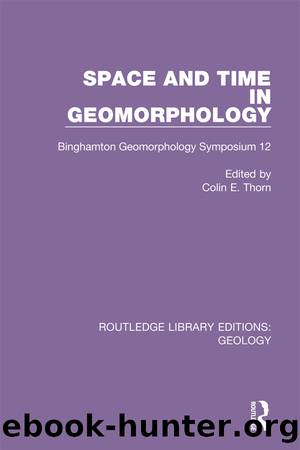Space and Time in Geomorphology by Thorn Colin E.;

Author:Thorn, Colin E.; [Thorn, Colin E.]
Language: eng
Format: epub
Publisher: Taylor & Francis Group
Published: 2020-03-21T00:00:00+00:00
FIGURE 8.2
Examples of radial growth curves from trees sampled at Cathedral Crags.
The Mt Elpoca site is located in the front ranges near Mt Rae. As in the other examples, a highway (Alberta 40) crosses the ephemeral channel. Snowmelt and rainfall are the primary water sources and some baseflow discharge is evident in a short reach of the channel through most summers. Morphologically, the site is similar to the site at Mt Hector. The upper catchment is composed of steep bedrock surfaces above treeline. The mid-section cuts through a suite of soft, erodable Mesozoic shales which provide copious debris to the system. The lower third of the site is composed of a paraglacial fan deposited over till and colluvium.
Flood-debris flow occurrences which obstructed the road were recorded in the summers of 1975 and 1979. These resulted from intense rainfall. The 1975 event followed a storm with an intensity of 80 mm/24 hours which has a return period of slightly more than 1 in 25 yr in this part of the Rockies.
Being in an isolated location, very little historical data exist for the Elpoca site. Therefore, dendrochronology was used to assess flood-debris flow occurrences in the recent past. The observed 1975 event is evident in growth series, indicating that the trees are sensitive to disturbance at this location. Three samples indicate growth anomalies and reaction wood in the mid-1950s. Subsequent examination of airphotos taken in the fall of 1954 and summer of 1955 indicate the occurrence of a very extensive flood-debris flow event in the intervening months. Field studies indicate both tree scarring without debris inundation as well as tree deformation with debris inundation, which suggests that the event involved a mixture of debris, water and snow indicating a spring thaw-rain combination. Tree growth patterns prior to 1955 indicate little disturbance, and deposits on the fan suggest little out-of-channel deposition of the 1955 magnitude. Fire destroyed part of the forest cover at this site in 1920, precluding dendrochronology beyond that date. Airphotos taken in the 1940s indicate little disturbance between then and 1920. Further sampling is required in the unburned part of the fan.
Data from the three locations indicate that combinations of morphological, botanical and historical information can be used to develop chronologies for the flood-debris flow mode of mass transfer. Over the past 2 yr, nine other sites have been examined using the same methods. As yet, all the data have not been systematically analyzed. However, preliminary impressions in combination with the results from the three sites discussed above suggest a pattern.
Flood-debris flow activity is a common occurrence in the Canadian Rocky Mountains under contemporary environmental conditions. Major out-of-channel occurrences have a frequency of 1 in 15 yr to about 1 in 25 yr. The Little Ice Age recession at the Cathedral site has generated a more frequent occurrence than that experienced prior to the recession. Extensive out-of-channel levées and lobe deposits at Hector and Elpoca indicate events of greater magnitude in the past 35 yr than in the previous century. The pattern is upheld at other sites.
Download
This site does not store any files on its server. We only index and link to content provided by other sites. Please contact the content providers to delete copyright contents if any and email us, we'll remove relevant links or contents immediately.
Man-made Catastrophes and Risk Information Concealment by Dmitry Chernov & Didier Sornette(5649)
The Revenge of Geography: What the Map Tells Us About Coming Conflicts and the Battle Against Fate by Kaplan Robert D(3961)
Zero Waste Home by Bea Johnson(3655)
In a Sunburned Country by Bill Bryson(3367)
COSMOS by Carl Sagan(3348)
Good by S. Walden(3347)
The Fate of Rome: Climate, Disease, and the End of an Empire (The Princeton History of the Ancient World) by Kyle Harper(2872)
Camino Island by John Grisham(2719)
A Wilder Time by William E. Glassley(2690)
Organic Mushroom Farming and Mycoremediation by Tradd Cotter(2565)
The Ogre by Doug Scott(2501)
Human Dynamics Research in Smart and Connected Communities by Shih-Lung Shaw & Daniel Sui(2431)
Energy Myths and Realities by Vaclav Smil(2380)
The Traveler's Gift by Andy Andrews(2299)
9781803241661-PYTHON FOR ARCGIS PRO by Unknown(2268)
Inside the Middle East by Avi Melamed(2230)
Birds of New Guinea by Pratt Thane K.; Beehler Bruce M.; Anderton John C(2175)
A History of Warfare by John Keegan(2105)
Ultimate Navigation Manual by Lyle Brotherton(2048)
